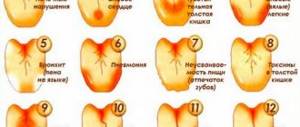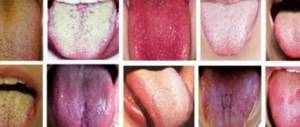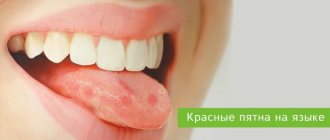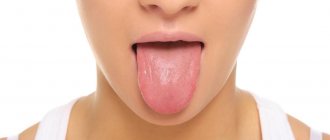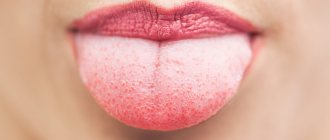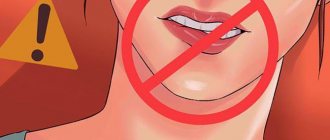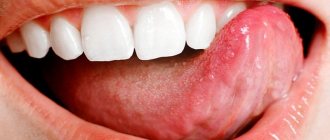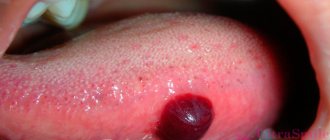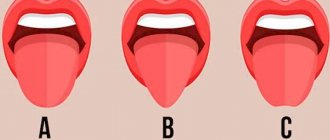The appearance of plaque on the tongue is not uncommon for anyone. People may often notice whitish deposits, which are normal in most cases and can be easily removed with special brushes. However, in rare cases, patients experience severe changes in the color of the tongue. When faced with dark plaque for the first time, people do not understand which doctor to contact and what diseases this unusual symptom may indicate.
- 5 How to remove dark plaque on the tongue?
- 6 Treatment prognosis and possible complications
- 7 Prevention
Causes of dark and black plaque
If a dark coating (even a black tint) has formed on the tongue, then the following diseases may be its causes:
- dysfunction of the gallbladder and pancreas (usually a bitter taste in the mouth),
- significant dehydration of the body,
- acidosis - a violation of the acid-base balance in the body, in which the level of acidity increases (for example, with excessive consumption of sweets, starchy foods and refusal of foods of plant origin),
- the presence of chromogenic fungal infections of the oral cavity (as a rule, they are accompanied by darkening of the tooth enamel),
- consumption of food containing dyes: natural (mulberry, blueberry, bird cherry, activated carbon, etc.) or artificial (all kinds of candies, confectionery, etc.),
- chronic intoxication of the body, when the level of toxins in the blood increases (when working in hazardous industries, living in environmentally unfavorable areas, as well as when the functions of the excretory system are impaired),
- infectious diseases of the oral cavity and pathologies of the ENT organs, for example, sore throat,
- alcoholism or systemic drug addiction,
- chemical poisoning (including gaseous substances),
- Crohn's disease,
- excess level of melanin in mucous membranes,
- in infancy – complementary foods introduced too early, when the child’s body is not yet ready to digest regular food,
- unbalanced, carbohydrate-deficient diets that cause metabolic or gastrointestinal dysfunction.
Of course, black deposits do not form in all of the listed situations, but mainly in combination (for example, in cases of serious and advanced diseases, with a simultaneous strong decrease in immunity).
Prevention
To prevent the manifestation of the disease, you must adhere to the usual standard recommendations:
- Daily proper hygiene procedures not only for the oral cavity, but also for the tongue.
- Eat more solid foods to help remove plaque.
- Regularly (at least 2 times a year) have your oral cavity examined by a dentist.
- Monitor your general well-being and body condition. If health problems arise, do not delay treatment.
- The use of rinses, the action of which is aimed at eliminating bacterial flora and reducing inflammation. Important: change rinse aids twice a month.
Herbal decoctions can be used as rinses:
- 1 tsp. herbs (linden flowers, oregano or plantain) pour 1 tbsp. boiling water, infused for 2 hours, filtered and used for its intended purpose.
- sage, chamomile and mint (in equal quantities) are poured with water and boiled over low heat for 15 minutes. After cooling, the broth is filtered.
Attention to your health, proper and balanced nutrition, quitting smoking and alcohol will also help prevent hyperplasia.
In the next video we will be told about what language changes should be alarming:
What plaque might look like
Depending on the location, plaques are divided into several types. It can be evenly distributed over the entire surface, can be concentrated in only one place (at the root, in the middle, on the side or at the tip), and can appear in the form of black dots. In addition, even the tongue itself can change color to gray or even black.
Interesting! A hundred years ago, darkening of the mucous membrane was clearly interpreted as a symptom of cholera. Modern medicine identifies at least 20 diseases that can provoke the formation of such plaque. Therefore, much attention is paid to diagnosis.
Definition
Black hairy tongue is a rare dental disease. There is another name for it - a chronic form of hyperplasia of filiform papillae (glossophytia).
It is characterized by a pathological change in the appearance of the tongue, which is expressed in the elongation of these papillae, compaction and thickening. Gradually they become keratinized and blackened.
Hypertrophic papillae are not always black. In the initial period of the disease, they can be brown, gray, or beige.
The more advanced the condition, the more intense and darker their color. Additionally, the blackness of the papillae is given by the chromatogenic bacteria that live on them.
This change affects only the posterior third and middle part of the organ. The anterior and lateral surfaces are usually not involved in the pathological process.
Additional symptoms for making an accurate diagnosis
In diagnosing diseases that cause blackening of the mucous membrane, other symptoms are also important. They allow you to more accurately determine the factor causing this pathology.
- the shade of the mucous membrane of the tongue itself: it can range from yellow-gray to black with a blue or green tint, it can have a brown color,
- localization of plaque: for example, a large black spot in the center of the tongue or at its root indicates gastrointestinal problems or complications after infectious lesions. Small black dots indicate fungal infections or chemical poisoning,
- mobility of the substrate (how easily it is removed from the surface of the organ),
- change in the relief of the back (formation of folds, growths, etc.),
- the presence of ulcers, abscesses or erosive lesions on all oral mucous membranes,
- presence of bad breath,
- the presence of a foreign taste: for example, bitterness indicates problems in the functioning of the gastrointestinal tract, a metallic taste indicates lead vapor poisoning, and sour taste indicates a fungal infection.
Types and colors - brown, gray, black, etc.
While for an ordinary person the details may not be important, the doctor very carefully studies the smallest details in the appearance of the tongue. There are many different shades of dark plaque:
- black can be a symptom of kidney pathology, nephritis;
- light brown indicates diseases of the skeletal and respiratory systems;
- yellow-brown is often observed with alcoholism, diseases of the gastrointestinal tract, and excessive use of drugs;
- dark brown occurs with dehydration, acute abdomen and serious disorders of the gastrointestinal tract;
- gray and dark gray can indicate chronic stomach diseases and constipation, candidiasis;
- purple indicates stagnation in the circulatory system;
- gray-green or brown-green occurs with cholecystitis and nephritis, oral candidiasis;
- gray-blue is found in Crohn's disease and cholera.
It is also important to evaluate its consistency. It can be dry or moist, fatty and cheesy. All these nuances indicate exactly how the disease progresses. It is necessary to see whether it is easily removed and whether there is any pain during this procedure.
The location of plaque on the surface of the tongue is studied separately:
- plaque on the tip of the tongue indicates diseases of the cardiovascular system;
- along the edges - about lung diseases;
- at the base of the tongue - about pathologies of the gastrointestinal tract;
- on the sides at the base - about liver and spleen disease.
Video about diseases that the tongue can talk about
What does a black spot on the tongue mean?
If a dark spot appears on the mucous membrane and it gradually increases in size, then you should immediately consult a doctor. This symptom may indicate serious disturbances in the functioning of the digestive system, a seasonal exacerbation of chronic diseases or respiratory complications, or an infectious lesion of various organs of our body (most often the genitourinary system).
In addition, such plaque can develop due to prolonged use of antibiotics. In this case, immunity decreases and the body can no longer control the population of bacteria and fungi.
In what case should you consult a doctor and undergo an examination?
If the deposits disappear on their own after rinsing your mouth or drinking, there is no need to go to the hospital, since the cause of the darkening of the tongue is most likely food.
If the plaque does not disappear when rinsing, but appears again after cleaning the tongue, you should make an appointment with a pediatrician.
If the blackening of the surface is accompanied by acute abdominal pain, diarrhea or vomiting, you should immediately consult a doctor or call an ambulance.
You should not try to treat your child yourself or try folk remedies without consulting a specialist and finding out the reasons for the blackening of the tongue.
You should know! Self-medication can cause serious harm to the baby's health.
What do black dots on the tongue mean?
One of the most common reasons for the appearance of such spots is the development of a fungal disease, including candidiasis (thrush). In the most vulnerable places on the mucous membrane, colonies of fungi grow, which become visible to the naked eye. A healthy body, as a rule, copes with harmful inhabitants, but if the immune system is weakened, the defense fails.
Remember! If treatment for a fungal infection is not started in time, it can provoke glossodynia - pathological growth and swelling of the lingual papillae, which increase in length, causing the feeling that hair is growing on the tongue.
Another unpleasant cause of blackheads is lead poisoning (Remak syndrome). As a rule, in this case, dark blue or black spots appear not only on the tongue, but also on the gums (in the form of a border) - due to the deposition of lead salts in the tissues.
Black tongue in Crohn's disease
Sometimes it happens that it is not the mucous membrane that darkens, but the organ itself. In this case, the tongue does not change shape and size, but darkens from the center to the edges. This indicates inflammatory processes in the digestive organs (most often in the small intestine) - Crohn's disease. Today, science cannot answer what is the cause of this pathology, but several prerequisites stand out: the presence of autoimmune diseases and disruption of the adrenal glands. As a result, due to hormonal deficiency, the level of melanin in the skin and mucous membranes increases, causing the integument to darken.
Read on the topic: causes of burning on the tongue - what does it mean and how to solve the problem?
Reviews
Glossophytia is not an independent disease, but is a consequence of the development of other diseases. Due to the slow and almost asymptomatic changes in the tongue, the pathology is detected late by a person. There is no need to panic; the disease is easily treated if the cause of its occurrence is eliminated.
If you are faced with a similar problem and want to express your opinion about the disease and treatment methods, leave them in the comments to this article.
If you find an error, please select a piece of text and press Ctrl+Enter.
Black plaque in children
In most cases, a black or bluish coating on a child’s tongue is the result of eating a product with a dye, for example, blueberries or chokeberries. In very young children, the changed color of the mucous membrane may be due to oxidation if the baby licked some kind of iron object. Therefore, first of all, it is worth finding out what the child played with and what if in the last 5-6 hours.
If the coloration of the mucous membrane is not associated with food intake, then you should contact your dentist or pediatrician (especially if the plaque does not go away for more than 48 hours). The reasons for changes in the color of the surface of the tongue in children may be inflammatory or degenerative phenomena in the body, the consequences of a previous sore throat, in which the mucous membrane of the pharynx often suffers due to irrigation with antibacterial drugs.
If this symptom is added to an increase in temperature, loss of stool, nausea, vomiting, weakness, insomnia, then we are most likely talking about inflammation of the digestive system or an infectious lesion.
Symptoms
- Dry mouth;
- unpleasant odor;
- change in taste;
- periodic or constant strong thirst that cannot be drowned out by anything;
- lack of appetite;
- sudden weight loss;
- memory impairment;
- bowel dysfunction (diarrhea, constipation), flatulence;
- change in skin color (yellowness, cyanosis or conspicuous pallor);
- nausea and vomiting, frequent belching, heartburn;
- changes in blood pressure, increased heart rate, increased body temperature.
Symptoms in this case are an additional factor in the clinical picture.
Diagnosis of diseases with black plaque
In order to identify the true cause of the pathology, the doctor must conduct an examination, which usually includes:
- general blood test (to detect inflammation and bacterial infections),
- bacterial culture from the oral cavity (to identify the type of fungal infection),
- biochemical blood test (to identify malfunctions of the hepatobiliary system and the functioning of the pancreas),
- coprogram, fecal occult blood test (to identify intestinal diseases),
- FGS, colonoscopy (to clarify the diagnosis in case of dysfunction of the gastrointestinal tract).
Complications
Lack of timely treatment for glossophitis can lead to the development of complications affecting the condition of the oral cavity:
- periodontal inflammation;
- extensive damage to dental caries;
- partial loss of taste perception;
- decrease in the amount of saliva produced;
- changes in microbiological flora;
- dry mucous membranes.
In addition to such “local” consequences, glossophytia negatively affects the general condition. Pathogenic bacteria from the papillae spread throughout the body, causing:
- ENT diseases: sinusitis, tonsillitis and sore throat.
- Dysfunction of the digestive organs.
- Respiratory pathology: pneumonia, bronchitis.
We will find out in the next publication whether there are analogues of Solcoseryl dental adhesive paste. And here we will tell you whether it is possible to sanitize the oral cavity yourself, at home.
By clicking on the following link: you can see a photo of gingival fibromatosis.
To prevent the development of such complications, it is important to seek help from specialists in a timely manner.
How to get rid of the problem
Treatment tactics depend on the factor that caused this condition. For example, Crohn's disease is treated comprehensively. The patient is prescribed hormonal therapy to balance hormonal levels, antibacterial drugs to treat inflammation of the gastrointestinal tract, and drugs that enhance immunity.
Important! If a dark coating is detected on the tongue, there is no need to self-medicate, because this pathology can be a symptom of a serious illness. Local treatment will not help, but will only worsen the situation. Therefore, when plaque appears on the mucous membrane, you should immediately contact a dentist or therapist so that they can prescribe a primary diagnosis and refer the patient to a specialist to establish a diagnosis.
Fungal infections are treated with antifungal drugs (local or general action).
Diseases of the digestive organs that cause a dark coating on the tongue are treated in accordance with the diagnosis; the tactics are chosen by a gastroenterologist. Often, along with drug therapy, a diet is prescribed or the diet is adjusted.
If the cause is chemical poisoning or intoxication, then the source of the toxins is determined (lead poisoning can be caused by fillings with a high content of this metal), detoxification measures and elimination of side effects are prescribed.
If no diseases were found during the examination, then it is generally accepted that dark plaque is a consequence of a malfunction in metabolism, and this problem is solved by adjusting the diet and drinking plenty of water (at least 2 liters of water per day for an adult).
If the cause of plaque formation lies in improper or insufficient oral hygiene, then the patient is advised to clean the tongue with a special soft brush with light movements, from the root of the tongue to its tip. In particularly advanced cases, dentists advise wiping the mucous membrane with a 5% solution of resorcinol or salicylic alcohol.
When not to worry
The use of certain medications causes the tongue to turn a particular color. Activated carbon turns black. Steroid drugs, Faringosept, Malavit - dark brown. Ulkavix, De-nol, Vikalin (drugs for the treatment of gastritis and heartburn) - in brown.
To identify false stains, conduct an experiment: within 3-4 days after brushing your teeth, brush your tongue. To do this, wrap a small piece of gauze around your finger, smear it with toothpaste and begin “sweeping” your tongue from root to tip.
Treat the right and left sides of the tongue in turn. Do not press or pull, but do everything carefully and smoothly so as not to damage the sensitive surface. After removing plaque, you should rinse your mouth with a healing herbal decoction or a special pharmaceutical product that protects against bacteria.
If the plaque is easily removed, the problem is due to foreign dyes and there is no reason to worry. Otherwise, observe for a few days. If there are no external factors that provoke staining, you need to consult a therapist or dentist. Moreover, a visit to the clinic should not be delayed if additional frightening symptoms appear.

